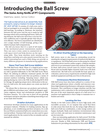Introducing the Ball Screw
Introducing the Ball Screw
The Swiss Army Knife of PT Components
The ball screw drive is an assembly that converts rotary motion to linear motion (or vice versa). It consists of a ball screw and a ball nut packaged as an assembly with recirculating ball bearings. According to Thomson, the interface between the ball screw and the nut is made by ball bearings which roll in matching ball forms. With rolling elements, the ball screw drive has a very low friction coefficient and is typically greater than 90 percent efficient. The forces transmitted are distributed over a large number of ball bearings, giving a low relative load per ball comparatively.
But did you know that it’s a jack-of-all-trades in the mechanical power transmission market? They can carry a tune, assist in commercial aircraft/space travel and help doctors on the operating table. They keep machine tools running on the shop floor and help turn solar panels toward the sun. It’s rather interesting how such a little thing can provide so many different purposes in manufacturing applications.

Name That Tune: Ball Screw Addition
The NSK Ball Screw Music Player is a magical power transmission jukebox of sorts that can play a variety of songs. Every ball is grinded differently in the NSK Ball Screw Music Player. By utilizing six different rotational speeds, the ball screws create a musical scale that can perform a variety of musical numbers including “Amazing Grace,” which was playing during my visit to the NSK booth during IMTS 2018 in Chicago. By applying unique micro-fabrication to the surface of a ball screw, the music player can create any kind of melody.





